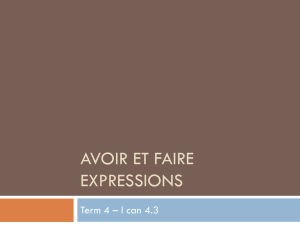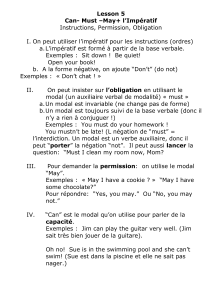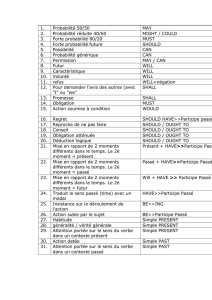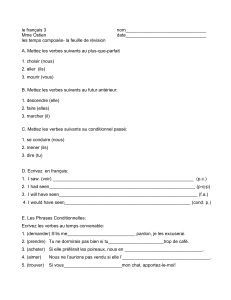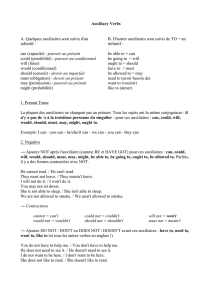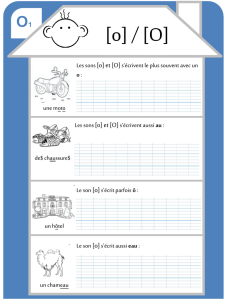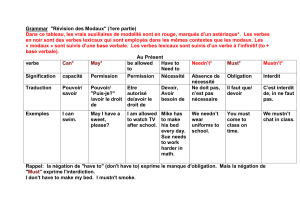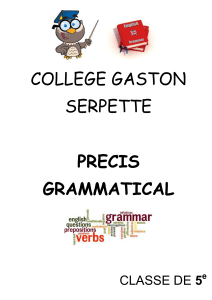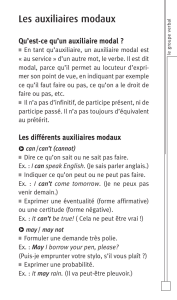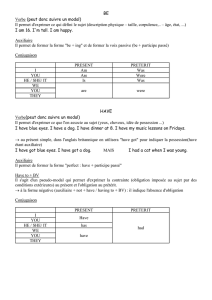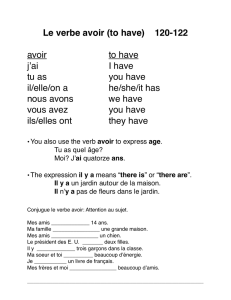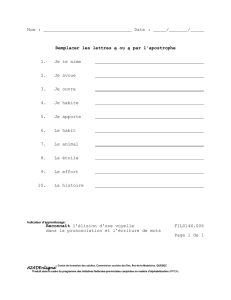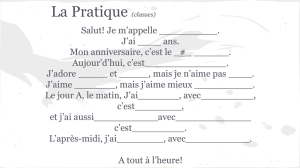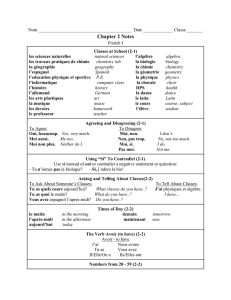I (20 points) :
publicité
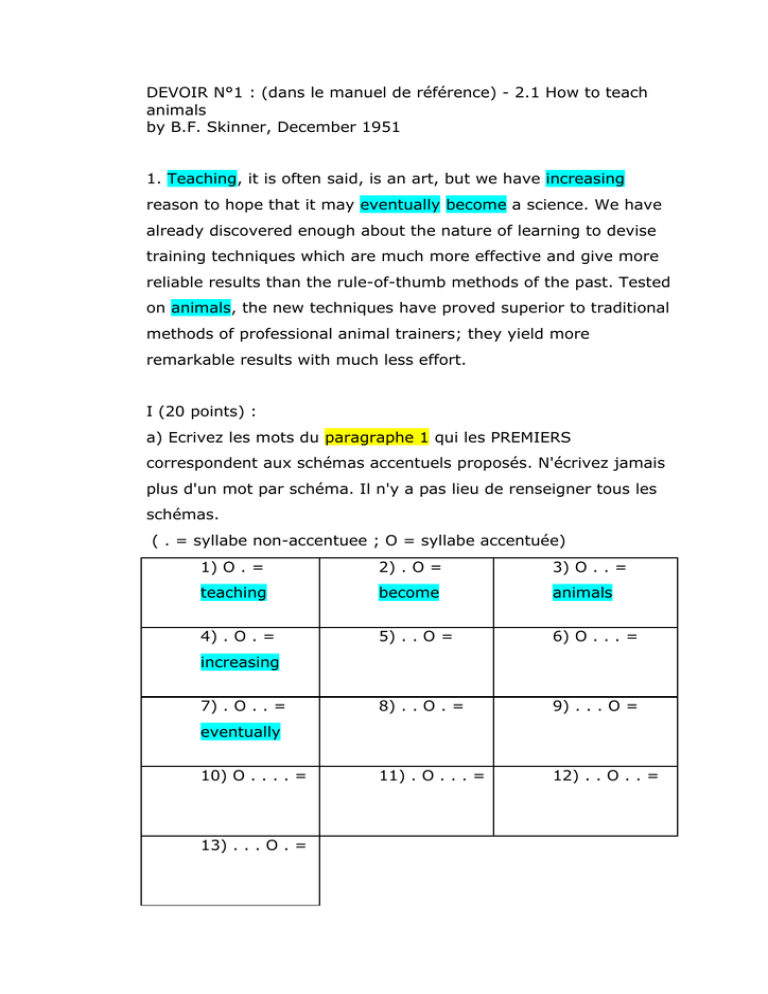
DEVOIR N°1 : (dans le manuel de référence) - 2.1 How to teach animals by B.F. Skinner, December 1951 1. Teaching, it is often said, is an art, but we have increasing reason to hope that it may eventually become a science. We have already discovered enough about the nature of learning to devise training techniques which are much more effective and give more reliable results than the rule-of-thumb methods of the past. Tested on animals, the new techniques have proved superior to traditional methods of professional animal trainers; they yield more remarkable results with much less effort. I (20 points) : a) Ecrivez les mots du paragraphe 1 qui les PREMIERS correspondent aux schémas accentuels proposés. N'écrivez jamais plus d'un mot par schéma. Il n'y a pas lieu de renseigner tous les schémas. ( . = syllabe non-accentuee ; O = syllabe accentuée) 1) O . = 2) . O = 3) O . . = teaching become animals 4) . O . = 5) . . O = 6) O . . . = 8) . . O . = 9) . . . O = 11) . O . . . = 12) . . O . . = increasing 7) . O . . = eventually 10) O . . . . = 13) . . . O . = Seul les mots du paragraphe 1 étaient concernés. b) Ecrivez le numéro correspondant à la prononciation de la voyelle accentuée. Exemple : si SOLUTION se trouvait dans le tableau, il faudrait écrire 11 . En effet, c'est la deuxième syllabe de "soLUtion" qui est accentuée et le son vocalique ("voyelle") est le même que dans 11 SHOE. 1 SHIP 6 EYE 11 SHOE 16 BOY 2 BIRD 7 CAR 12 CUP 17 HEAR 3 SHEEP 8 DOG 13 CAKE 18 HAIR 4 HEAD 9 HORSE 14 MOUTH 19 POOR 5 HAT 10 FOOT 15 NOSE ULTIMATELY=12 IMPORTUNATE=9 METHODICAL=8 ESTABLISHMENT=5 KANGAROO=11 REDUCTION=12 DISCUSSION=12 APPLICABILITY CONSTITUTION=11 GOODNESS=10 PRIMORDIAL=9 INERTIA =2 PORTUGUESE =3 =1 POSSIBLE =8 PUBLISHED =12 Voici une méthode qui n'est pas infaillible, mais permet, dans la quasi totalité des cas, d'identifier la prononciation de la voyelle accentuée. Vous remarquerez que, dans ce devoir, une des 3 règles de base était applicable pour chaque mot. ULTIMATELY=12 KANGAROO=11 CONSTITUTION=11 Règle 2 : ATE IMPORTUNATE=9 Règle 3 : OO REDUCTION=12 Règle 1 : i+voyelle GOODNESS=10 Règle 2 : ATE Règle 1 : Règle 3 : OO METHODICAL=8 i+voyelle DISCUSSION=12 PRIMORDIAL=9 Règle 1 : IC Règle 1 : Règle 1 : i+voyelle i+voyelle ESTABLISHMENT=5 APPLICABILITY INERTIA =2 Règle 1 : ISH =1 Règle 1 : i+voyelle PORTUGUESE =3 Règle 1 : ITY POSSIBLE =8 PUBLISHED =12 Règle 3 : ESE Règle 1 : IBLE Règle 1 : ISH II ( 20 points ) a) (4pts) Relevez dans les paragraphes 5 et 6 QUATRE groupes verbaux noyaux de proposition et ayant des structures différentes (un changement de temps n'est pas un changement de structure). Ne donnez qu'un groupe verbal par structure. N'écrivez que le groupe verbal noyau (ni sujet, ni complément(s)...). Tout élément non verbal entraînera la nullité de la réponse. J'ai surligné tous les groupes verbaux noyaux de proposition. Mais il ne fallait relever qu'un seul exemple par structure. Si, par exemple, vous aviez écrit "is contitioned", vous ne pouviez plus écrire "is given" qui a la même structure. 5. The reinforcement gives you a means of control over the behavior of the animal. It rests on the simple principle that whenever something reinforces a particular activity of an organism, it increases the chances that the organism will repeat that behavior. This makes it possible to shape an animal's behavior almost as a sculptor shapes a lump of clay. There is of course nothing new in this principle. What is new is a better understanding of the conditions under which reinforcement works best. 6. To be effective a reinforcement must be given almost simultaneously with the desired behavior; a delay of even one second destroys much of the effect. This means that the offer of food in the usual way is likely to be ineffective; it is not fast enough. The best way to reinforce the behavior with the necessary speed is to use a "conditioned" reinforcer. This is a signal which the animal is conditioned to associate with food. The animal is always given food immediately after the signal, and the signal itself then becomes the reinforcer. The better the association between the two events, the better the result. Couleurs associées aux structures : 1° Verbe 2° Modal + Verbe 3° Modal + BE>>Participe passé (passif) + Verbe 4° BE>>Participe passé (passif) + Verbe 1 = gives 2 = will repeat 3 = must be given 4 = is conditioned b) (6pts) Ecrivez les groupes verbaux correspondants. ( MODAL = n'importe quel modal ) PRESENT + (BE >> ing) + (BE >> Participe passé) + LEAVE => He is being left PASSE + MODAL + (HAVE >> Participe passé) + TAKE => He could/might/should/would have taken PRESENT + MODAL + (HAVE >> Participe passé) + (BE >> Participe passé) + THINK => He can/may/must/shall/will have been thought PRESENT + (HAVE >> Participe passé) + (BE >> ING) + WORK => He has been working PRESENT + MODAL + (BE >> ing) + LEND => He => He can/may/must/shall/will be lending PASSE + (HAVE >> Participe passé.) + (BE >> Participe passé) + SEE => He had been seen Attention aux verbes irréguliers Voyez ce document nécessaire et suffisant. Il vous présente les verbes irréguliers (78) à connaître absolument. Chacun est accompagné d'un exemple et de sa traduction. Les verbes de l'examen seront choisis parmi eux c) (5pts) Posez la question portant sur le/les mots entre parenthèses : 1- A special project focusing on bloggers has (shined a spotlight on the growing influence of new media). What has a special project focusing on bloggers done? 2- (The project) was launched last summer. What was launched last summer? 3- They must set out to bring (the people's) voice to the highest circles of leadership. Whose voice must they set out to bring to the highest circles of leadership? 4- He expects blogs to play an even greater role (in the future). When does he expect blogs to play an even greater role? 5- They often had (sports cars). What did they often have? Pour ce type d'exercice, comme pour le suivant, il est très important de comprendre le mécanisme de la transformation DANS LA LANGUE ANGLAISE avant de traduire. La plupart des erreurs sont dues au fait que vous traduisez, puis vous vous appuyez sur ce que vous avez trouvé en français pour re-traduire ensuite en anglais ! Suivez plutôt ces méthodes : 1°) pour la transformation interrogative Présentation d'une méthode(pps) + Leçon en ligne 2°) pour la transformation passive (voyez ci-dessous) Présentation d'une méthode(PPS) + Présentation sonorisée d) (5pts) Mettez les phrases suivantes au passif. 1. Todd Lucier maintained a popular blog on climate change. A popular blog on climate change was maintained by Todd Lucier. 2. Blogging may have caught the attention of world leaders The attention of world leaders may have been caught by blogging. 3. A consortium of non-governmental organizations has launched the project. The project has been launched by a consortium of nongovernmental organizations. 4. They must be breaking the monopoly. The monopoly must be being broken. 5. Many journalists will see the G-20 summit as an opportunity to make a difference. The G-20 summit will be seen by many journalists as an opportunity to make a difference. ou The G-20 summit will be seen as an opportunity to make a difference by many journalists.
![Le son [j] - 9raya.net](http://s1.studylibfr.com/store/data/004031545_1-da08eb24f74f35a1ca13b3b6fc032e54-300x300.png)
